7 Species of Woodpeckers in Tennessee
Last Updated on
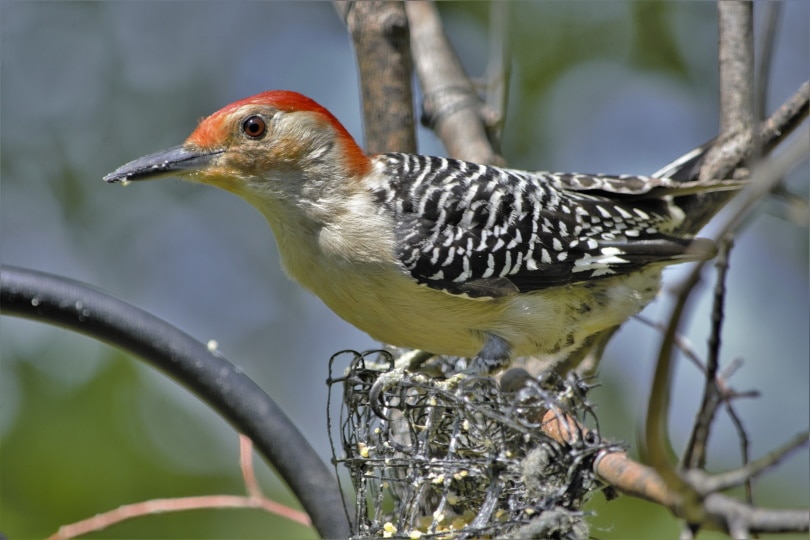
While Woody the Woodpecker might be the most famous of all the cartoon woodpeckers out there, in real life, he’s a type of pileated woodpecker that you can easily find in Tennessee!
With seven different woodpecker species in the state, the pileated woodpecker is far from the only woodpecker that you can spot. Here, we highlight all seven woodpecker species in the state, go over their favorite habitats, and provide a few tips that you can use to attract woodpeckers to your yard!

The 7 Species of Woodpeckers in Tennessee
1. Red-Bellied Woodpecker
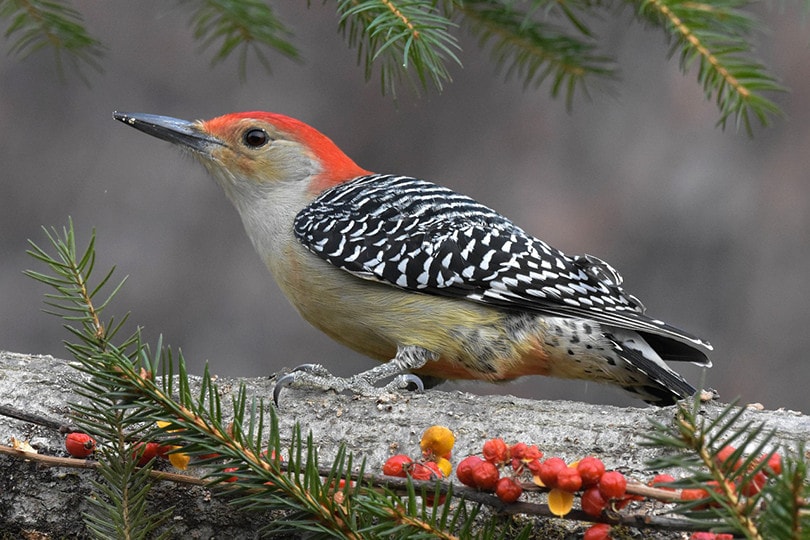
| Scientific name | Melanerpes carolinus |
| Population | 16 million |
| Size | 9 to 11 inches |
| Habitat | Deciduous forests near rivers and streams |
| Diet | Acorns, nuts, fruits, seeds, sap, eggs, and small fish |
The red-bellied woodpecker is the most populous woodpecker in Tennessee, but unless you head to a forest or a stream, there’s a good chance that you won’t see one.
These woodpeckers primarily feed on nuts, acorns, fruits, seeds, sap, and everything else that they can get from trees, but occasionally, they’ll venture out. When they do, they might chow down on other birds’ eggs or catch small fish to eat.
They’re not the largest woodpeckers out there, but they’re not the smallest either.
2. Downy Woodpecker

| Scientific name | Picoides pubescens |
| Population | 13 million |
| Size | 5.7 to 6.7 inches |
| Habitat | Wilderness areas and suburban yards |
| Diet | Insects and seeds |
Technically, there are fewer downy woodpeckers in Tennessee than red-bellied woodpeckers, but they’re usually easier to spot. While they still populate various areas of wilderness, they’ve also ventured into suburban areas.
Downy woodpeckers prefer to eat insects, but they will eat seeds, especially during the winter months when insects aren’t quite as plentiful. Downy woodpeckers are gorgeous birds, and they’re the smallest woodpeckers that you’ll find in Tennessee.
3. Pileated Woodpecker
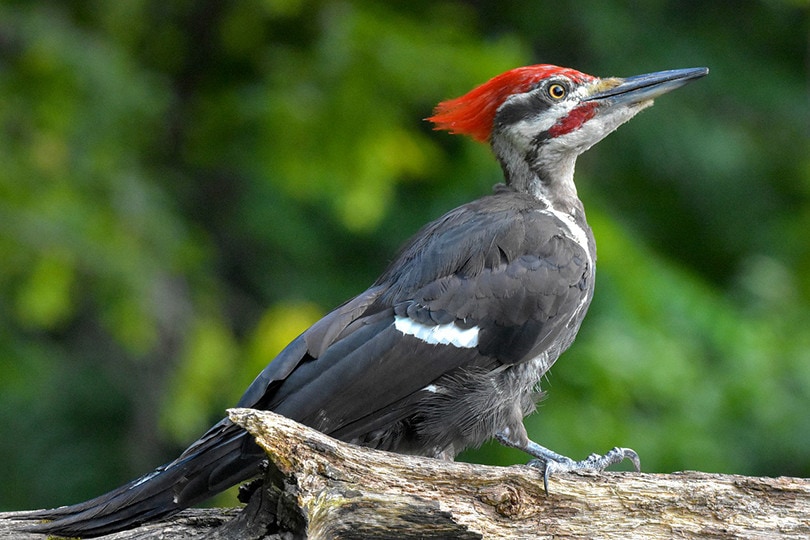
| Scientific name | Dryocopus pileatus |
| Population | 1.9 million |
| Size | 16 to 19 inches |
| Habitat | Forest |
| Diet | Insects and larvae |
While there are 1.9 million pileated woodpeckers in the world, that still puts their population numbers on the smaller side of things. They live solely in forests, and they’re among the largest woodpeckers out there.
A fully mature pileated woodpecker can be over 1 ½ feet in size, which is three times the size of the downy woodpecker! These birds only feed off insects and larvae, so they have to find plenty to survive.
4. Hairy Woodpecker

| Scientific name | Leuconotopicus villosus |
| Population | 9 million |
| Size | 9 to 11 inches |
| Habitat | Mature forests, suburbs, and parks |
| Diet | Insects, berries, seeds, and nuts |
While the hairy woodpecker might not be as common in Tennessee as the downy woodpecker, they’re not exactly rare either. There are 9 million hairy woodpeckers in the world, and you’ll find most of them in mature forests.
However, you’ll occasionally see them in suburbs and parks. They eat primarily insects, but they will also eat seeds and nuts to supplement their diet.
So, while it’s not likely that you’ll see them eating from a bird feeder, it is still a possibility if they’re not finding enough insects to eat.
5. Yellow-Bellied Sapsucker

| Scientific name | Sphyrapicus varius |
| Population | 4 million |
| Size | 7.1 to 8.7 inches |
| Habitat | Hardwood and conifer forests |
| Diet | Insects, tree sap, fruits, and nuts |
The yellow-bellied sapsucker might not sound like a woodpecker from the name, but these are indeed medium-sized woodpeckers. You can typically find them in forests throughout the state — specifically, hardwood or conifer forests.
So, if you travel to those regions and look at the trees, there’s a good chance that you’ll spot one. They primarily feed on insects, but as their name suggests, they’ll chow down on tree sap too.
When they’re not getting enough insects and sap, they will eat the various fruits and nuts that they can find in the forest too.
6. Northern Flicker
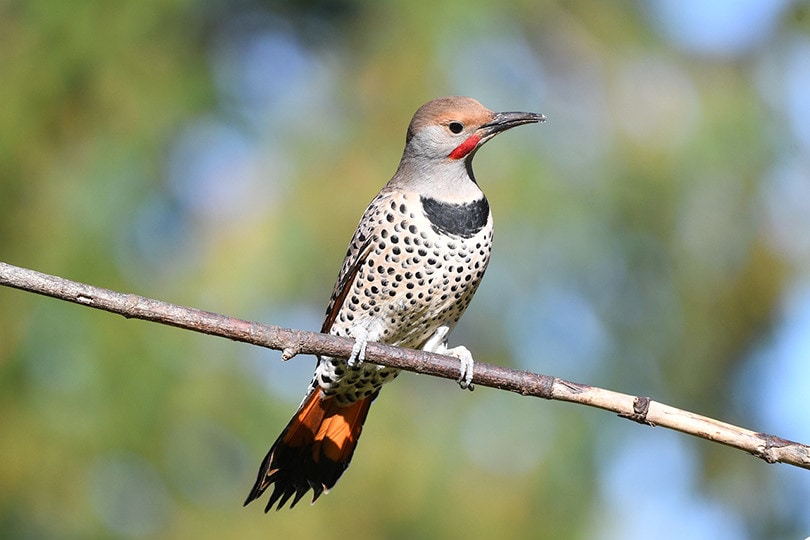
| Scientific name | Colaptes auratus |
| Population | 16 million |
| Size | 7.1 to 8.7 inches |
| Habitat | Woodland, forest edges, open fields, city parks, and suburbs |
| Diet | Insects, fruits, and seeds |
With a population of 16 million northern flickers, there’s no shortage of these woodpeckers. They’re highly adaptable birds, so you can see them in a wide variety of settings. As woodpeckers, they’ll thrive in woodland and forest edges, but they can live in other environments too.
You can find these birds in city parks, cemeteries, and even suburban environments. They prefer to eat insects, but they have no problem frequenting a bird feeder with seeds if they’re around.
Just keep in mind that these birds are slightly large at just over 1 foot in size, so you’ll need to get a bird feeder with a large opening if you want a northern flicker to eat from there.
7. Red-Headed Woodpecker
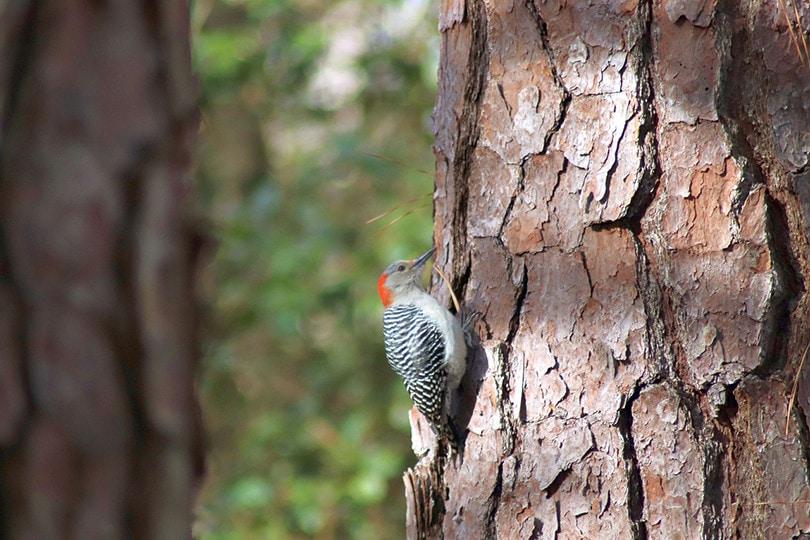
| Scientific name | Melanerpes erythrocephalus |
| Population | 1.2 million |
| Size | 8.3 to 9.8 inches |
| Habitat | Groves, farms, orchards, open woods |
| Diet | Seeds, acorns, corn, nuts, and fruits |
The red-headed woodpecker is the hardest woodpecker to spot in Tennessee, and that has to do with their dwindling numbers. With just 1.2 million red-headed woodpeckers left, they have the smallest population of all the woodpeckers in Tennessee.
You can spot these beautiful birds on groves, above farms, in orchards, and in areas of open woods. They avoid large unbroken sections of forest, instead preferring open spaces.
They’ll eat seeds, acorns, corn, nuts, fruits, and just about any other natural foods, so they will find and use your feeders if they’re around.
- Related Read: 8 Species of Woodpeckers in Pennsylvania (With Pictures)

Tips for Attracting Woodpeckers to Your Yard
Attracting a woodpecker to your yard is all about getting the environment right for them, and there are a few simple things that you can do to help encourage visits. First, you need natural scenery in your yard.
Having bushes and gardens is an excellent place to start, but hardwood trees are better options for woodpeckers. They might take a while to grow, but they’re the most effective method to attract woodpeckers.
Second, if you can’t get trees in your yard, try installing an elevated nesting box for the type of woodpecker that you’re trying to attract. Unless you live in a heavily forested area, you probably want to focus on a nesting box for downy woodpeckers or the northern flicker.
Finally, these birds need something to eat! While many woodpeckers rely on insects, every woodpecker in Tennessee besides the pileated woodpecker enjoys seeds from time to time.
Even if your birdfeeder doesn’t attract a woodpecker, there’s sure to be plenty of aviary life that does stop by.
When Is the Best Time of Day to Spot Woodpeckers?
If you’re heading out to try to spot a woodpecker, early morning is the best time to look for them. They are more active in the morning hours, and the sound of them pecking typically travels farther at this time.
You’ll likely hear a woodpecker in the forest before you spot them, so keep your ears open and stay as quiet as possible. The last thing that you want to do is scare them away because they hear you approaching.

In Conclusion
If you’re interested in spotting woodpeckers and live in Tennessee, you’re in a good spot. There are millions of these birds in the state, and if you live in the right area, you might not even need to leave your home to spot one!
So, whether you prime your yard or prepare for a road trip, you won’t need to go far to spot a woodpecker near you.
Featured Image Credit: Scottslm, Pixabay
About the Author Robert Sparks
Robert’s obsession with all things optical started early in life, when his optician father would bring home prototypes for Robert to play with. Nowadays, Robert is dedicated to helping others find the right optics for their needs. His hobbies include astronomy, astrophysics, and model building. Originally from Newark, NJ, he resides in Santa Fe, New Mexico, where the nighttime skies are filled with glittering stars.
Related Articles:
10 Types of Hummingbirds in Arkansas (With Pictures)
8 Types of Hummingbirds in Nebraska (With Pictures)
5 Types of Hummingbirds in Idaho (With Pictures)
3 Types of Hummingbirds in Mississippi (With Pictures)
8 Types of Hummingbirds in Kansas (With Pictures)
5 Types of Hummingbirds in West Virginia (With Pictures)
5 Types of Hummingbirds in Ohio (With Pictures)
Where Do Nuthatches Nest? Nuthatch Nesting Habits Explained
